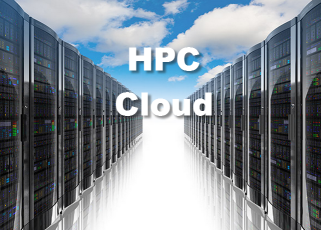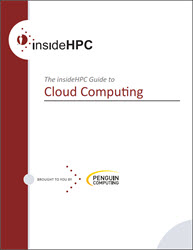This is third article in a series on Cloud Computing for HPC. This article series is taken from an insideHPC guide that describes the challenges that users face and the solutions available to make running cloud based HPC applications a reality. This week we explore why HPC in the Cloud may make sense for your organization.
Why HPC in a Cloud Environment?
High-performance computing (HPC) generally refers to the practice of aggregating computing power in a way that delivers much higher performance than one could get out of a typical desktop computer or server in order to solve large problems in science, engineering or business. Depending on the problem type and the science and algorithm used, these applications can require just one or thousands of compute cores running together. The range of use for HPC-type technologies runs the gamut from a small company designing components for a larger integrator (think automobile supplier for a major automobile manufacturer) to Department of Energy (DOE) labs that own and maintain the fastest computers in the world that, for example, investigate climate change and nuclear weapon simulations. Although many of these use cases are not suitable for running their HPC and ISV applications in the cloud, a significant number of those running technical programs can benefit from cloud computing environments. There are a number of business reasons to consider HPC in the cloud.
- Project deadlines – There are times of the year when extra compute power is needed, but only for a short period of time, such as in order to meet a project deadline. It does not make financial sense to purchase hardware that may only be used for one week per quarter, or perhaps during the final design run before production. In some organizations, the lack of adequate HPC servers can create long wait times in queues, reducing innovation or causing projects to be delayed.
- Reduce in-house infrastructure – Running and maintaining a data center for HPC applications is costly and requires power and cooling in addition to the servers and storage. Dedicated parts of a physical building must be built and include proper HVAC systems and/or water cooling systems. This can get very expensive and the square footage cannot be used for other business-related purposes.
- Latest software versions – ISV applications, which are used heavily in commercial HPC environments, release new versions periodically. With an in-house data center, someone must be sure to monitor the ISV update and release schedule, and then install either patches or new versions. By using a cloud provider that has relationships with the ISV, this maintenance is taken care of and performed without the end user having to be concerned.
- Latest hardware available – New and faster processors and systems incorporating these are released frequently. If a company or organization were to purchase new servers or storage, a process involving many people would have to be followed, and include creating a request for proposal, understanding the bids, evaluating choices, and implementing and integrating the new servers or storage into an existing environment. The entire process would take time and personnel expense. By counting on the cloud provider to house the latest and highest-performing servers and storage systems, organizations can focus on their business and services more and not become burdened by having to purchase servers, storage and networking.
- Reduce in-house maintenance – Even when a data center is up and running, time must be spent to monitor and maintain the infrastructure. From downloading patches and new versions and monitoring the system’s health, a significant amount of time must be allocated for these tasks. System administrators may have to be on call 24 hours a day to solve critical issues. When working with a cloud provider, these tasks are the responsibility of the cloud provider and are part of a service-level agreement that would include uptime guarantees and network access.
A recent IDC survey indicated that about 25 percent of sites that ran HPC workloads are using some sort of cloud computing, and that just over 30 percent of the HPC workloads were being performed at cloud sites.
Next week we’ll explore the critical cloud requirements for HPC. If your prefer you can download the entire series in a PDF from the insideHPC White Paper Library, courtesy of Penguin Computing.





